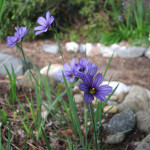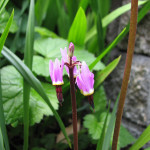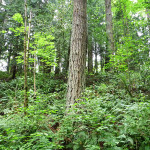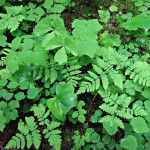
Native plants provide many benefits to people and wildlife, while contributing to healthy soil and water. Below is a quick list of seven good things native plants do or provide. For much more detailed information on native plants and where you can obtain them, be sure to check out our Native Plant Resources section!
Native plants don’t need intense fertilizing. Lawns and ornamental plantings often need yearly inorganic fertilizer to thrive. When it rains, excess phosphorus and nitrogen (the main components of inorganic fertilizers) run off into our waterways, causing large amounts of algae growth. When the algae die, their decomposition depletes oxygen in the water. This harms or kills fish and other aquatic life. Native plants do fine with just organic compost or no fertilizer at all.
Native plants don’t need pesticides. They are hardy and adapted to native pests, and native plants support beneficial insect populations, which provide natural pest control without chemicals. In contrast, millions of pounds of pesticides are used every year to maintain lawns and ornamental plants. These chemicals contaminate our soil and water, and cause a range of health problems for humans and our pets. Pesticides also kill beneficial insects like pollinators and predators. Keep you, your family, and your landscape healthy by using native plants!
- Blue-eyed grass (Sisyrinchium idahoense), a native groundcover – low-growing with small bluish-purple to blue-violet flowers.
- A Red Admiral (Vanessa Atalanta) butterfly on some Douglas aster flowers. Native plants are very important for native and migratory pollinators.
- Broad-leaf shooting star (Dodecatheon hendersonii) has an interesting “inside-out” bloom and is summer deciduous, dying back to the ground after the rains cease.
- By including a variety of plants of different sizes and heights in your yard, you can mimic the natural features that provide food, habitat and structure for wildlife.
- A variety of natives makes for a beautiful groundcover layer that will require very little maintenance over time!
Native plants help you use less water. The modern lawn requires significant amounts of water to thrive. In urban areas, lawn irrigation uses as much as 30% of the water consumption on the East Coast and up to 60% on the West Coast. native plants are adapted to the Pacific Northwest’s dry summers, however, and their deep root systems actually increase the soil’s ability to soak up and store water. Compared to lawns, native landscapes absorb more water and reduce flooding.
Native plant landscapes don’t create air pollution. Natural landscapes require much less maintenance than manicured lawns and ornamental bushes. In the state of California, gas-powered lawn equipment is responsible for more ozone pollution than all cars combined. Air pollution is hazardous to human health and contributes to global warming. Native plants are pollution-free, and actually help remove carbon from the air and store it in the soil.
Native plants support pollinators and other wildlife. Native plants attract a variety of birds, butterflies, and other wildlife by providing food and shelter. Native plants support native insects, which support native wildlife. Chickadees, for example, need 70% native plants in their territory to successfully raise their young. The over 30 million acres of lawns in the U.S., on the other hand, support almost no wildlife.
Native plants promote local biodiversity and stewardship of our natural heritage. Using locally grown native plants in your landscape makes your yard part of the larger ecosystem. Your plants provide genetic diversity to nearby wild plant populations, which are the foundation of healthy, resilient natural systems. Planting native plants is one of the best things you can do to care for the planet.
Native plants save homeowners money in many different ways. According to the EPA, conventional landscape maintenance can cost 5x as much as natural landscape maintenance over a 10 year period. And not only are native plants inexpensive compared to lawns, but non-native invasive plants are extremely costly! According to a 2020 study commissioned by the OR Dept. of Agriculture, invasive plants cost Oregon an estimated $83.5 million a year in control and lost working-lands productivity.
Explore over 50 plants in our Native Plant Database!





